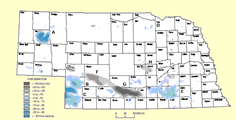Natural Resources, School of

Conservation and Survey Division: Faculty and Staff Publications
Document Type
Article
Date of this Version
9-1997
Citation
Flowerday, C. A., Diffendal, R. F., Jr., editors, 1997. Geology of Niobrara State Park, Knox County, Nebraska, and Adjacent Areas, with a Brief History of the Park, Gavins Point Dam, and Lewis and Clark Lake. Lincoln, Nebraska: Conservation and Survey Division, University of Nebraska-Lincoln, 28 pp.
Abstract
Location
Niobrara State Park is located in northwestern Knox County, Nebraska, just west of the town of Niobrara and on the west side of the Niobrara River. The present park was opened in the summer of 1987. Mostly north of Nebraska Highway 12, the site is hilly with bluffs overlooking the Missouri and Niobrara rivers. Excellent facilities include paved roads, cabins, an outdoor swimming pooi, hiking trails, picnic and camping sites, horseback riding trails, playgrounds, restrooms, a group lodge, and an interpretive shelter. Many vantage points in the park have beautiful views of the lower Niobrara Valley and the middle Missouri Valley. Lovers of native plants and wildlife can see many different species in and near the park. Park grounds are open all year. The park office, about 1.5 miles northwest of the park entrance, is open daily from mid-April to mid-November, and weekdays at other times of the year (figs. 1 and 2).
Purposes
This educational circular describes the prehistory and history of Niobrara State Park, Gavins Point Dam and its reservoir-Lewis and Clark Lake-and several aspects of the geology of the park and nearby or adjoining areas. Sections include information on minerals, fossils, stratigraphy, and geologic history, but the principal focuses of this circular are on the work of and changes in the Niobrara River and on geologic hazards in the area.
Cautions
Caution is advised when visiting the park or any other area. A void walking on landslide areas. Stay away from steep hill slopes. Be careful when working on dark shale exposures on hot days because temperatures on these shales reach well above 100 degrees F. Poison ivy, stinging insects, and other such hazards occur. Be careful! We remind readers that collecting of any kind is prohibited in the park and that permission must be obtained from property owners before going on or collecting from private property.
Included in
Geology Commons, Geomorphology Commons, Hydrology Commons, Paleontology Commons, Sedimentology Commons, Soil Science Commons, Stratigraphy Commons


Comments
EC-13